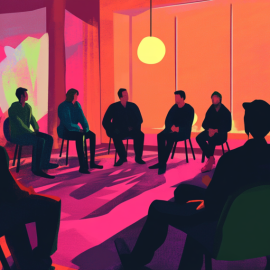

This article is an excerpt from the Shortform book guide to "The Confidence Game" by Maria Konnikova. Shortform has the world's best summaries and analyses of books you should be reading.
Like this article? Sign up for a free trial here.
Why do people fall for scams? How do con artists gain the trust of their victims?
If you’ve ever fallen for a scam, you probably feel embarrassed or ashamed. But the con artist manipulated you to think you could trust them like an old family friend.
Check out how con artists use a false sense of trust to get what they want, according to The Confidence Game by Maria Konnikova.
How Scammers Gain Your Trust
Why do people fall for scams? Konnikova explains con artists use information to gain your trust. The con artist uses three main tools that automatically make us more likely to trust someone: similarity, familiarity, and appeals to emotion.
When leveraging similarity, the con artist might mirror back the traits, interests, or experiences they observed in you. For example, they might pretend they graduated from the same university as you or lived in the same town. This subtly nudges you to trust the con artist because you’re so much alike—in other words, if you think of yourself as trustworthy, then you assume this other person just like you must also be trustworthy.
(Shortform note: Some researchers refer to the tendency to trust people who are similar us as the “similar-to-me” effect and argue that it can have both positive and negative effects depending on the circumstances. For example, it can cause managers to hire people who have similar life experiences, personality traits, or physical characteristics as them, leading to less diverse staff and perpetuating gender disparities in some industries. On the other hand, if shared traits foster more trusting relationships between managers and employees, this can improve job satisfaction and performance for the whole team.)
To appeal to familiarity, the con artist might pretend they’re a friend of a friend. This appeals to your sense of being a good judge of character by suggesting that if they’re already linked to you through a mutual friend, then they deserve your trust. Or, they might pretend that they work at the same company as you and stage a casual run-in before introducing the con in your second encounter. Since they’re an “acquaintance” that you’ve had one positive experience with, you’re automatically more likely to trust them.
(Shortform note: In addition to being more likely to trust people who are familiar, people also have a natural tendency to prefer items that seem familiar—a bias that’s often important for marketers. For example, in The 22 Immutable Laws of Marketing, Al Ries and Jack Trout explain that the first brand available for a product tends to become the default product that consumers will buy because it’s more familiar and people form an attachment to it.)
Konnikova notes that both similarity and familiarity can be faked with very little background information. In addition, the more we trust someone, the more information we share, giving the con artist an even greater advantage in manipulating us. (Shortform note: A con artist might also get a mark to reveal more information by first pretending to be vulnerable with them. If the con artist shares information about their past, for example, the social norm of reciprocity might make people feel pressured to share something about their past in return.)
Lastly, Konnikova explains that con artists gain your trust by appealing to your emotions. In particular, when someone tells you a sad story, it activates your empathy and makes you more likely to let your guard down and trust that person.
(Shortform note: Recent advancements in AI have led to new types of scams that target emotions such as high fear response. Instead of convincing the mark to trust a stranger, AI technology can now “clone” the voice of the mark’s loved one (replicate it based on an audio clip) and use this familiar voice that the mark already trusts via a phone call. The AI voice can then convince the mark to pay money to get the loved one out of harm’s way. For example, in one incident, a con artist used AI to clone the voice of a teenage girl who was away from her family and then used it to call her mom, stage a kidnapping scenario, and demand a ransom.)
Trust Is More Beneficial Than Skepticism
Konnikova writes that this part of the con is possible because humans have a natural instinct to trust others. Trust was evolutionarily beneficial for our human ancestors, as they were more likely to survive when living in groups that could better defend their people and provide resources collectively. Living cooperatively required trust and as a result, our ancestors benefited from trusting by default. We thus don’t have an astute ability to detect when people are deceiving us.
(Shortform note: Research suggests that in addition to the evolutionary advantages of trusting others, early experiences in life can influence how trusting and cooperative people tend to be in adulthood. For example, when children grow up in an environment with stable and reliable caregivers, they’re more likely to trust others later in life.)
Emotion Clouds Judgment
Another evolutionary explanation for why con artists can easily gain our trust is that emotional reactions impact our cognition before we have time to make a logical assessment. According to Konnikova, this is biologically advantageous because emotions like fear activate a flight response (allowing us to escape and survive) without us having to process what’s happening. She writes that we interpret emotions largely based on nonverbal cues like tone, facial expressions, and posture, so con artists can make a strong, emotional first impression on us that will continue to impact our decisions even after we’ve learned contradictory information.
For example, a con artist might make a positive emotional impact on us (and therefore gain our trust) by appearing friendly, generous, and charming using both nonverbal and verbal cues. These might include using a soothing or upbeat tone of voice or striking up a friendly conversation. Then, even when things go wrong, we’ll be reluctant to accept the truth because we’re so attached to our initial positive emotional response.
(Shortform note: The tendency to base decisions on emotional impressions is often leveraged in sales techniques as well. For example, in Contagious, Jonah Berger says that to engage your prospective customers when marketing a product, it’s important to inspire an emotional response rather than giving them lots of information. This strategy is consistent with Konnikova’s idea that an emotional response overrides a rational assessment. Berger writes that physiologically arousing emotions—such as awe, excitement, amusement, anger, and anxiety—are particularly useful for getting customers to buy a product.)

———End of Preview———
Like what you just read? Read the rest of the world's best book summary and analysis of Maria Konnikova's "The Confidence Game" at Shortform.
Here's what you'll find in our full The Confidence Game summary:
- The social psychology behind cons, and why they work
- How con artists swindle and manipulate their victims
- Actionable advice for spotting and avoiding cons






